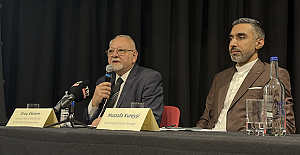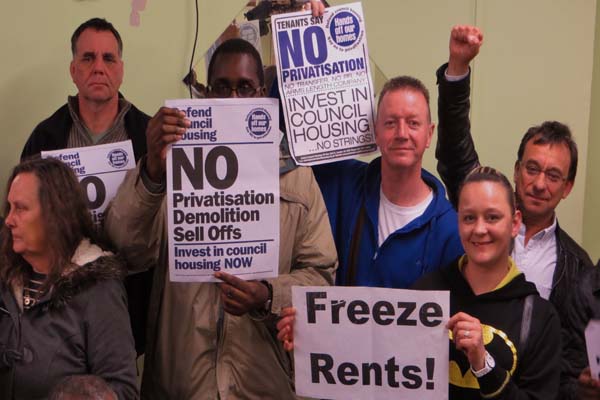Paulette Hamilton, chair of the Love Lane Residents’ Association, in North Tottenham, says, “We’re the first people that will be transported out of Tottenham, and many to different places”. More private and more expensive housing is planned by the Council, with much less tenant security. But the Council consistently denies the facts about its demolition plans and their likely impact. Campaigners will be meeting on Thursday evening in Tottenham to step up their campaign against demolitions. Everybody is welcome to come along.
Plans endorsed by the Council’s Cabinet last month include new demolition areas on the East side as well as the West side of the High Road in North Tottenham, with more council homes set for demolition at Stellar House, Cooperage Close, and in a crudely-drawn sketch map, parts only of the nearby Altair Close, the Lindales and Bennetts Close as well. Almost all of the homes set for demolition are council housing. The report is brutally clear that new housing would be mainly private, more expensive for residents, and less secure. 30% is set for private ownership, 20% private renting, 30% “Affordable home ownership/intermediate”, and 20% with near market rents (up to double council rent levels) and time-limited five year tenancies in contrast to the permanent tenancies that council tenants enjoy.
Sadly, there are no plans to build new council homes in Tottenham to replace those set for demolition.
Many people have asked for more detail on Haringey Council's plans to dispose of or demolish much of its council housing stock of 15,922 tenanted dwellings. So here are some references on the Council policies which would raise market rents and raise house prices, driving local people out of our own localities and neighborhoods. The references which follow are to six Haringey Council documents, and three additional sources. Phrases such as “more balanced tenure mix” are used throughout Haringey’s housing strategy documents to mean the disposal or demolition of council housing; and ‘estate renewal’ is a further euphemism for the demolition and clearance of council housing.
The Council’s ‘Housing Investment and Estate Renewal Strategy’ (Cabinet Report, 28/11/13) states that decent homes work does not provide for investment in council housing with complex issues, or which can never be made decent (paragraph 6.7 on page 9). From Appendix 2, we can deduce that around 947 tenanted council homes are to be excluded from the Council’s decent homes programme ending in April 2016, and will remain non-decent.
This is despite promises more than nine years ago, in the Almo ballot of 2005, that decent homes would be delivered for all Haringey council tenants in the event of a ‘yes’ vote. These 947 homes are now amongst those set for demolition or disposal.
Paragraph 6.11 of the same report casually refers to council housing as a cause of social deprivation. We disagree. The authors forget that many council tenants have been private tenants in the past, and that we learned something from the experience: that council housing is a good thing for renters, and it enables us to better ourselves and enjoy better lives.
Paragraph 8.2 states that estate renewal will be strategic, focusing on estates where there is “opportunity to influence the tenure balance of neighbourhoods by increasing the number of affordable, private rented sector, housing ladder type products or market sale homes”. As these are all council estates to begin with, the intention is very clear: to privatise, and to replace council rent with insecure, higher-cost private housing.
“Larger estates in Tottenham suffer from high quantities of one and two-bed accommodation that has led to a high proportion of single vulnerable residents and serious overcrowding. These estates have also typically suffered from: low levels of employment, educational attainment, household income and life expectancy; and high levels of crime and benefit dependency”. [Paragraph 8.9 on page 13; Emphasis in the original]. This is another very clear statement that the council considers council housing to be a cause of social ills. We reply that council tenants are being blamed for social problems not of our own making.
Similarly, para 8.12 on page 14 links housing investment issues in Noel Park, Wood Green N22, with the seemingly irrelevant statement that some tenants are unemployed, and with alleged high crime rates on Wood Green High Road. I have lived in this area for twelve years, and have always felt safe and secure on the High Road. Haringey Councillors should accept that unemployed or socially excluded people need decent and secure homes as much as anybody else.
The report claims that the expected regeneration investment needed for council estates will be beyond the scope of the Housing Revenue Account, leading to pressure on tenants for privatisation. We must therefore be concerned that Haringey’s Medium Term Financial Plan to March 2017, appendix 1, page 7, shows that £1.5 million has been allocated from the Housing Revenue Account (that is, our rent and service charges) over the next three years 2014-17, to communicate with residents about the need for estate renewal.
We can expect there to be biased, partial communications to promote plans that have already in effect been decided upon, which would end by pricing local people out of our own areas. This is a misuse of our rent and leasehold charge funds.
The Tottenham strategic regeneration framework (LBH, draft for consultation November 2013) states of Northumberland Park in North Tottenham that >>Housing options in the area are… quite limited with over half of the housing consisting of affordable housing<< (page 31).
The ‘Key actions’ include >>Explore with the local community their ambitions for housing estate renewal in Northumberland Park with the aim of improving the quality and tenure mix and creating mixed and balanced communities<< (page 32).
Haringey Council’s Site Allocations Consultation Document, Jan-Feb 2014, on page 72, referring to estate renewal in North Tottenham, highlights 297 council homes at Love Lane / Whitehall Street and 1,072 council homes in Northumberland Park, and claims that,
“A key issue in Tottenham is the quantum of social housing tenure and poor quality housing stock. In order to improve existing housing choice and increase overall housing supply, the opportunity exists to invest in new and existing housing that will produce a mixed and balanced community. Regeneration of existing housing estates will create opportunities to contribute to tacking the borough’s housing need, and diversify the existing housing stock in the area both in terms of mix and tenure.”
Low housing densities on existing council estates are identified as a problem that the masterplanners wish to address: “The proposed programme of estate renewal in Tottenham provides the opportunity to address the proportion of Haringey’s housing that makes poor use of available land and that has negatively affected the quantum and quality of the housing provided” (Scoping Report on Tottenham Area Action Plans, January 2014). High density, building on more open spaces and green spaces, and building higher, are the planners’ preferred solutions.
None of these Haringey Council reports mention the secure, permanent tenancies presently provided by the council for its 15,922 tenants, which we should be pleased about and proud of, or the lowest rents in the rental sector, which council housing presently delivers. There is no focus on or strategy to deal with the problems of private landlordism, or the unaffordable housing association near-market rent model, which nine London Councils (not including Haringey) brought court action against the Mayor of London, attempting to control and oppose. Nor is there much concern for the 9,838 households on the Haringey’s council waiting list, at the last count, who need and want council housing.
There are positive alternatives to the gentrification plans. The introduction of Housing Revenue Account reform in April 2012 allows more headroom for direct investment in council housing, and in response some other councils have council housebuilding programmes, without demolitions of any existing council stock. Where the Housing Revenue Account settlement is inadequate to meet investment needs, Haringey should go back to government alongside colleagues in the Local Government Association, and also lobby local MPs to press for debt restructuring and the write-off of historic debt, so that council housing can continue to play a valuable role in sustaining inclusive mixed-income communities.
The election addresses of the Labour candidates in the May elections tacitly acknowledged that voters’ priorities include more really-affordable and council housing; and 48 of the 57 Labour candidates were successful in the elections. Well done. Yet the council plans to build only 100 new council homes in the next two years, and according to Cllr Alan Strickland (Ham and High newspaper, 04/12/13), even they may be some other kind of social housing, or shared ownership; while the Council aims to demolish thousands more council homes in the drive towards gentrification.
The Council’s “Invest in Tottenham” video on You Tube shows the council’s aspiration for dense, private sector, high-rise developments, as an alternative to council housing, and the council’s willingness to meet developer requirements on ‘flexible’ planning regulations and high-rent, insecure tenancies.
The Billboards around the Spurs ground on the High Road promoting “Major Sport-led regeneration for Tottenham” show crowds of happy people, rather affluent and youthful, as the adverts always do. But these crowds are noticeably mainly white. They are ethnically distinct from the diverse and largely black Tottenham people of today. So place-changing means people-changing, and market forces would price out many existing residents, if council housing is demolished and the council rent regime is scrapped.
We therefore recommend that Haringey’s housing policies be revisited and reconsidered by the new Council elected in May 2014, with its 29 freshly-elected members out of a total of 57.


 After Nesil Caliskan a by-election will be held in Jubilee ward in Enfield
After Nesil Caliskan a by-election will be held in Jubilee ward in Enfield Publishing the analysis, Labour’s Cllr Ergin Erbil said Everybody in Enfield deserves basic rights
Publishing the analysis, Labour’s Cllr Ergin Erbil said Everybody in Enfield deserves basic rights Gaza-Israel conflict Statement from Cllr Ergin Erbil, Leader of Enfield Council
Gaza-Israel conflict Statement from Cllr Ergin Erbil, Leader of Enfield Council Cllr Ergin Erbil was elected as the new Leader of Enfield Council
Cllr Ergin Erbil was elected as the new Leader of Enfield Council Cold weather health alerts issued ahead of snow
Cold weather health alerts issued ahead of snow London defies weather with spectacular fireworks display to ring in 2025
London defies weather with spectacular fireworks display to ring in 2025 Alim Karaca, who hosted Bill Gates, Jeff Bezos, Trump, talked about Fethiye
Alim Karaca, who hosted Bill Gates, Jeff Bezos, Trump, talked about Fethiye History of the Turkish Cypriot People symposium held in London
History of the Turkish Cypriot People symposium held in London Footballers are celebrating after Enfield Council officially opened a pitch
Footballers are celebrating after Enfield Council officially opened a pitch  Pep Guardiola's Manchester City beaten by Juventus
Pep Guardiola's Manchester City beaten by Juventus Chelsea to meet Arsenal in Sunday's London derby
Chelsea to meet Arsenal in Sunday's London derby Fenerbahce vs Manchester United Predicted line-ups! Jose Mourinho faces former side
Fenerbahce vs Manchester United Predicted line-ups! Jose Mourinho faces former side UK economy had zero growth between July and September
UK economy had zero growth between July and September Shape the future of housing services with The Enfield 500
Shape the future of housing services with The Enfield 500 DOUBLE-CAB PICKUPS TO BE CLASSED AS CARS UNDER NEW HMRC POLICY
DOUBLE-CAB PICKUPS TO BE CLASSED AS CARS UNDER NEW HMRC POLICY Guide to Selling Hoodies with Imprinted Book Quotes
Guide to Selling Hoodies with Imprinted Book Quotes

















